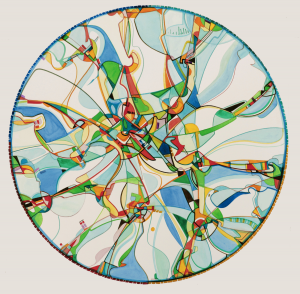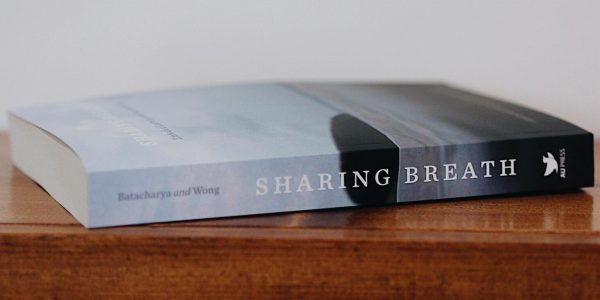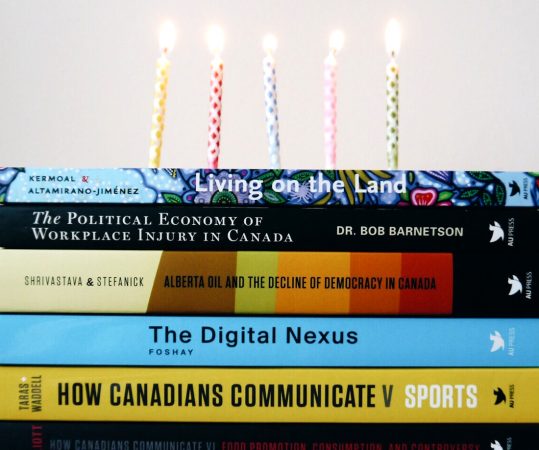Photo: Detail of Tsątsąke k’e (Iron Foot Place) by Alex Janvier in Rogers Place.
Did you know that all Edmontonians are treaty people? About half of Canada’s land is covered by eleven numbered treaties that date back to the late 19th and early 20th centuries. Treaty 6 includes the midsections of Alberta and Saskatchewan and binds the residents of those areas – First Nations and non-Indigenous alike – with the same force as the Canadian constitution. Here’s some history:
- Treaty 6 was first signed on August 23, 1876, at Fort Carlton, just north of what is now Saskatoon.
- Five nations signed Treaty 6: the Plains Cree, Wood Cree, Nakoda, Saulteaux, and Dene.
- Cree comprise the largest group of First Nations peoples in Canada, and the Plains Cree were the original inhabitants of the area we now call Edmonton.
- Edmonton’s Cree name is amiskwaciwâskahikan (“uh-missk-wuh-chi-wask-hag-in”), which is most often translated as “Beaver Hills House” but more literally means “Beaver Mountain House.”
- Northern Alberta is part of Treaty 8, and southern Alberta is part of Treaty 7. The southwest tip of Treaty 10 covers land north of Lac La Biche.
The City of Edmonton held its first “Treaty No. 6 Recognition Day” in 2013. This year’s event, on 18 August, will see Edmonton’s mayor and city council join First Nations chiefs from across Alberta, as well as the grand chief of the Confederacy of Treaty Six First Nations, for a special ceremony at City Hall. The day is a reminder of the commitment they made to peaceful and productive relations between their governments, as per the Memorandum of Cooperation and Dialogue signed in 2012. In a move toward advancing the ongoing process of reconciliation, the day also affirms a commitment to inclusion and respect for all cultures that make Edmonton home.
Aside from attending the event at City Hall, here are a few ways the everyday Edmontonian can recognize treaty.
Familiarize yourself with the United Nations Declaration on the Rights of Indigenous People (UNDRIP). The UNDRIP was created a decade ago, but Canada only accepted the document in 2016. Consider how basic the rights listed seem, and how you would probably expect to be treated this way were it your rights in question. Recognize that this document was drawn up because, in many cases, these rights were not being extended to Indigenous people around the world – including 1.4 million people in Canada.
Read a book about the experiences of this land’s first peoples. AU Press has some good offerings to this end, the newest being Arthur Bear Chief’s My Decade at Old Sun, My Lifetime of Hell. I mention a few others in my earlier blog post.
Check out Groundwork for Change, including their comprehensive “List of great websites to learn more.” Chelsea Vowel has also developed a series of primers, available on her website under “Indigenous Issues 101.”
Practice listening more and speaking less. Challenge yourself to stay open to answers you weren’t expecting, and expect that these issues will be difficult for some people to talk about.
Learn a few words in Cree, especially if you think it’s important to learn either of Canada’s official languages. The online Cree dictionary is a great tool for finding specific words, and is available as an app on both Android and iOS.
amisk = beaver
waciy = hill or mountain
wâskihakan = house
Go for a walk. The valley that Edmonton’s trail system winds its way through is home to plants like sage, sweetgrass, Saskatoon berries, and tamarack – plants that helped the first peoples in this region make their lives. Find a guide to show you proper harvesting techniques, or spend some time simply enjoying the rich sensory experience offered by the forest.
How do you recognize treaty in your daily life? Let us know in a comment below!
Written by Virginia Dowdell, summer intern at AU Press.



